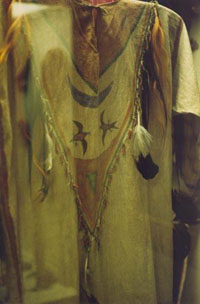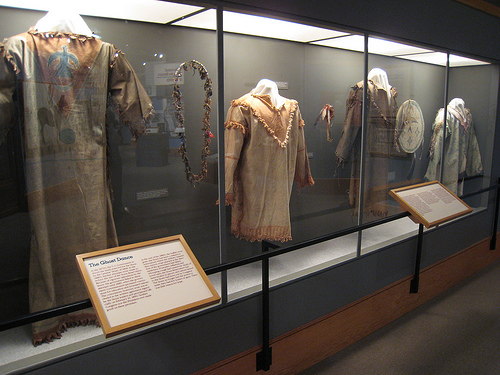



|

Home :
History :
Images :
The Role of Ghost Shirts & Ghost Dance Dresses
The Role of Ghost Shirts & Ghost Dance Dresses
by James Mooney
NOTE: It is now believed that the Sioux were one of the few tribes that associated Ghost Shirts and Ghost Dance Dresses with war, and most tribes wore them for purely peaceful purposes in conjunction with the Ghost Dance ceremony. However, the following essay by James Mooney published in 1896 helped to shape popular understanding of these garments and is therefore an important historical document.
 The most noted thing connected with the Ghost dance among the Sioux is the “ghost shirt” which was worn by all adherents of the doctrine—men, women, and children alike. During the dance it was worn as an outside garment, but was said to be worn at other times under the ordinary dress. Although the shape, fringing, and feather adornment were practically the same in every case, considerable variation existed in regard to the painting, the designs on some being very simple, while the others were fairly covered with representatives of sun, moon, stars, the sacred things of their mythology, and the visions of the trance. In some cases the fringe or other portions were painted with the sacred red paint of the messiah. The shirt was firmly believed to be impenetrable to bullets or weapons of any sort. When one of the women shot in the Wounded Knee massacre was approached as she lay in the church and told that she must let them remove her ghost shirt in order the better to get at her wound, she replied: “Yes; take it off. They told me a bullet would not go through. Now I don’t want it any more.”
The most noted thing connected with the Ghost dance among the Sioux is the “ghost shirt” which was worn by all adherents of the doctrine—men, women, and children alike. During the dance it was worn as an outside garment, but was said to be worn at other times under the ordinary dress. Although the shape, fringing, and feather adornment were practically the same in every case, considerable variation existed in regard to the painting, the designs on some being very simple, while the others were fairly covered with representatives of sun, moon, stars, the sacred things of their mythology, and the visions of the trance. In some cases the fringe or other portions were painted with the sacred red paint of the messiah. The shirt was firmly believed to be impenetrable to bullets or weapons of any sort. When one of the women shot in the Wounded Knee massacre was approached as she lay in the church and told that she must let them remove her ghost shirt in order the better to get at her wound, she replied: “Yes; take it off. They told me a bullet would not go through. Now I don’t want it any more.”

The protective idea in connection with the ghost shirt does not seem to be aboriginal. The Indian warrior habitually went into battle naked above the waist. His protecting “medicine” was a feather, a tiny bag of some sacred powder, the claw of an animal, the head of a bird, or some other small object which could be readily twisted into his hair or hidden between the covers of his shield without attracting attention. Its virtue depended entirely on the ceremony of the consecration and not on size or texture. The war paint had the same magic power of protection. To cover the body in battle was not in accordance with Indian usage, which demanded that the warrior should be as free and unencumbered in movement as possible. The so-called “war shirt” was worn chiefly in ceremonial dress parades and only rarely on the warpath.
Dreams are but incoherent combination of waking ideas, and there is a hint of recollection even in the wildest visions of sleep. The ghost shirt may easily have been an inspiration from a trance, while the trance vision itself was the result of ideas from previous observation or report. The author is strongly inclined to the opinion that the idea of an invulnerable sacred garment is not original with the Indians, but, like several other important points pertaining to the Ghost-dance doctrine, is a practical adaptation by them of ideas derived from contact with some sectarian body among the whites.
 It may have been suggested by the “endowment robe” of the Mormons, a seamless garment of white muslin adorned with symbolic figures, which is worn by their initiates as the most sacred badge of their faith, and by many of the believers is supposed to render the wearer invulnerable. The Mormons have always manifested a particular interest in the Indians, whom they regard as the Lamanites of their sacred writings, and hence have made special efforts for their evangelization, with the result that a considerable number of the neighboring tribes of Ute, Paiute, Bannock, and Shoshoni have been received into the Mormon church and invested with the endowment robe. The Shoshoni and northern Arapaho occupy the same reservation in Wyoming, and anything which concerns one tribe is more or less talked of by the other. As the Sioux, Cheyenne, and other eastern tribes make frequent visits to the Arapaho, and as these Arapaho have been the great apostles of the Ghost dance, it is easy to see how an idea borrowed by the Shoshoni from the Mormons could find its way through the Arapaho first to the Sioux and Cheyenne and afterward to more remote tribes. Wovoka himself expressly disclaimed any responsibility for the ghost shirt, and whites and Indians alike agreed that it formed no part of the dance costume in Mason valley. When I first when among the Cheyenne and neighboring tribes of Oklahoma in January, 1891, the ghost shirt had not yet reached them. Soon afterward the first one was brought down from the Sioux country by a Cheyenne named White Buffalo, who had been a Carlisle student, but the Arapaho and Cheyenne, after debating the matter, refused to allow it to be worn in the dance, on the ground that the doctrine of the Ghost dance was one of peace, whereas the Sioux had made the ghost shirt an auxiliary of war. In consequence of this decision such shirts have never been worn by the dancers among the southern tribes. Instead they wear in the dance their finest shirts and dresses of buckskin, covered with painted and beaded figures from the Ghost-dance mythology and the visions of the trance.
It may have been suggested by the “endowment robe” of the Mormons, a seamless garment of white muslin adorned with symbolic figures, which is worn by their initiates as the most sacred badge of their faith, and by many of the believers is supposed to render the wearer invulnerable. The Mormons have always manifested a particular interest in the Indians, whom they regard as the Lamanites of their sacred writings, and hence have made special efforts for their evangelization, with the result that a considerable number of the neighboring tribes of Ute, Paiute, Bannock, and Shoshoni have been received into the Mormon church and invested with the endowment robe. The Shoshoni and northern Arapaho occupy the same reservation in Wyoming, and anything which concerns one tribe is more or less talked of by the other. As the Sioux, Cheyenne, and other eastern tribes make frequent visits to the Arapaho, and as these Arapaho have been the great apostles of the Ghost dance, it is easy to see how an idea borrowed by the Shoshoni from the Mormons could find its way through the Arapaho first to the Sioux and Cheyenne and afterward to more remote tribes. Wovoka himself expressly disclaimed any responsibility for the ghost shirt, and whites and Indians alike agreed that it formed no part of the dance costume in Mason valley. When I first when among the Cheyenne and neighboring tribes of Oklahoma in January, 1891, the ghost shirt had not yet reached them. Soon afterward the first one was brought down from the Sioux country by a Cheyenne named White Buffalo, who had been a Carlisle student, but the Arapaho and Cheyenne, after debating the matter, refused to allow it to be worn in the dance, on the ground that the doctrine of the Ghost dance was one of peace, whereas the Sioux had made the ghost shirt an auxiliary of war. In consequence of this decision such shirts have never been worn by the dancers among the southern tribes. Instead they wear in the dance their finest shirts and dresses of buckskin, covered with painted and beaded figures from the Ghost-dance mythology and the visions of the trance.
See Also:
The Glasgow Ghost Shirt
|

